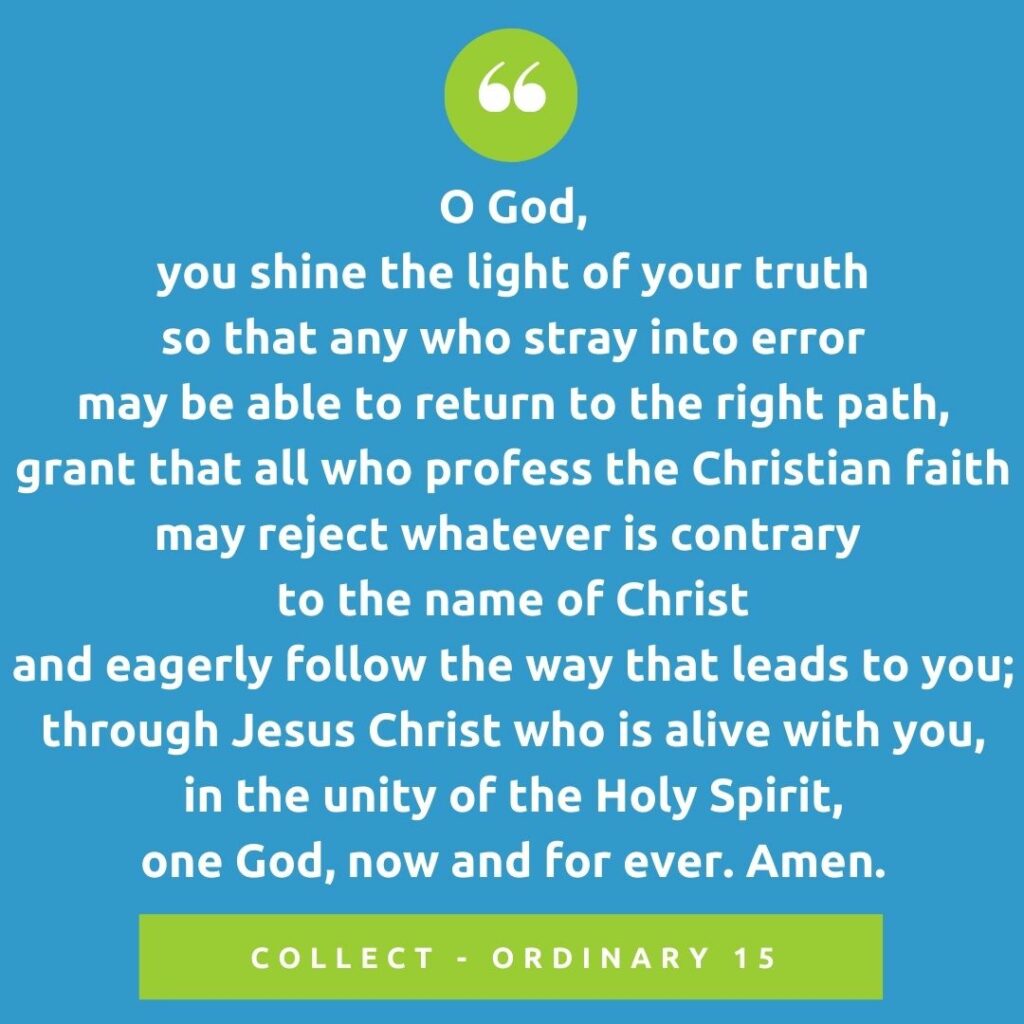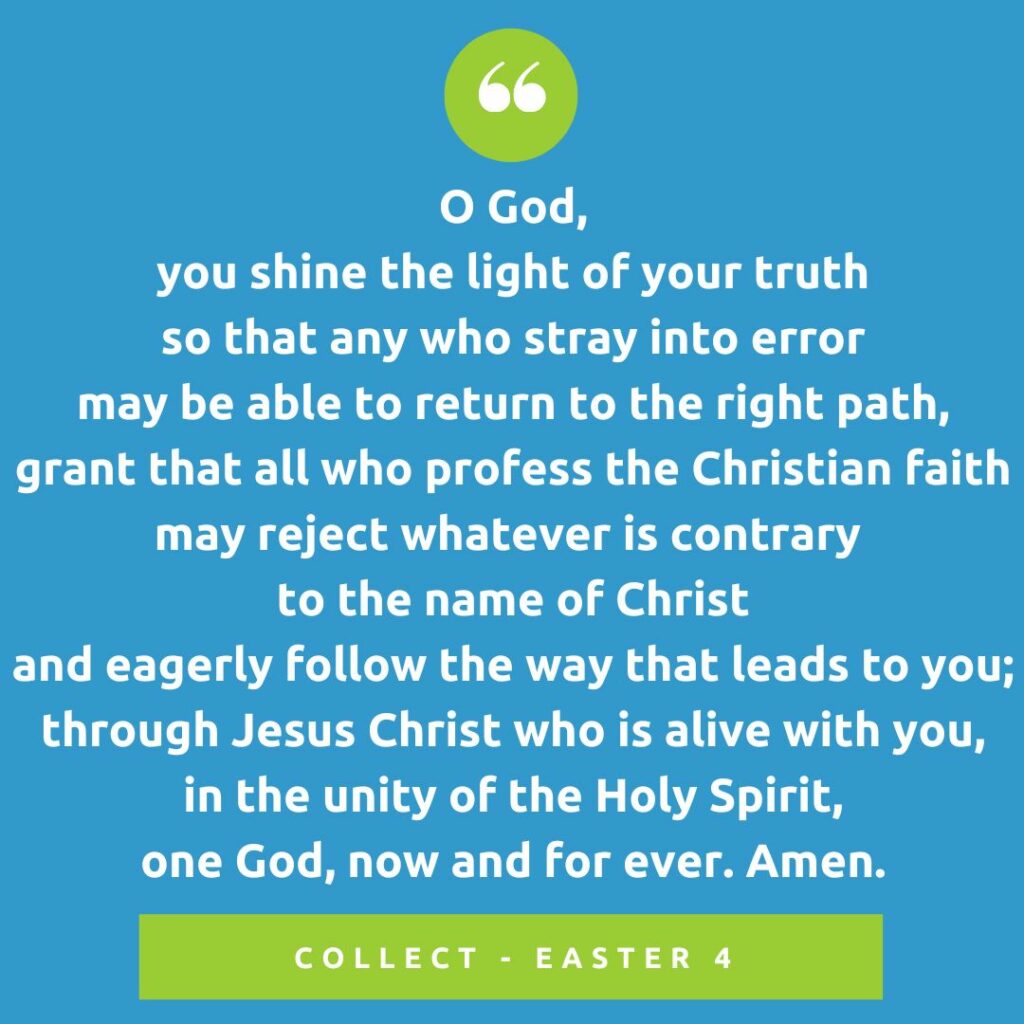
Let us pray (in silence) [that we may follow the Good Shepherd]
pause
O God,
you shine the light of your truth
so that any who stray into error
may be able to return to the right path,
grant that all who profess the Christian faith
may reject whatever is contrary to the name of Christ
and eagerly follow the way that leads to you;
through Jesus Christ
who is alive with you,
in the unity of the Holy Spirit,
one God, now and for ever.
Amen.
The above prayer has been revised in the light of a helpful comment. The pre-updated prayer is at the bottom.
The above is my reworking for my Book of Prayers in Common in which I seek to provide a set of collects with history and commentary.
The oldest form of this prayer is found in the Verona Sacramentary (561-574 AD) included among other Masses for the month of April. From the Gelasian Sacramentary until the 1962 RC Missal [including Leonine (no. 75)], it was assigned, with consistent wording, to what we now call the Fourth Sunday of Easter (first the Second Sunday after the Octave of Easter, then the Third Sunday after Easter – all the same day, merely with different nomenclature):
Deus, qui errantibus, ut in viam possint redire justitiae, veritatis tuae lumen ostendis, da cunctis qui christiana professione censentur, et illa respuere, quae huic inimica sunt nomini, et ea quae sunt apta sectari.
Literally:
God, you show the light of your truth to those in error so that they might return to the way of righteousness; grant to all those who profess Christ, both to reject those things that are inimical to this name, and to follow those things that are fitting to it.
Cranmer translated this for the 1549 BCP as:
ALMIGHTYE God, whiche shewest to all men that be in errour the light of thy truth, to the intent that they maie returne into the waye of righteousnes; Graunt unto all them that bee admitted into the felowship of Christes religion, that they maye exchew [eschew] those thinges that be contrary to their profession, and folow all such thinges as be agreable to the same; through our Lorde Jesus Christ.
After Vatican II, the Gospel readings for this Sunday, in all three years, are from John 10 – Jesus the Good Shepherd. Roman Catholics then moved this collect to the 15th Sunday in Ordinary Time and also used it for Monday of the 3rd week of Easter season (also changed to “errantes ut in via possent redire – that erring ones would be able to return on the way” and dropped “justitiae”). In 2002 it was removed from Monday of the 3rd week of Easter season. I think it is still an appropriate collect to retain on its traditional Sunday, the Fourth Sunday of Easter. This is a prayer for those who wander about in the dark. May we who follow Christ, the Good Shepherd, also reflect and focus the light for others.
This can be read as another to flee-and-to-follow collect. The baptismal imagery of light, truth, way, righteousness, admitted, fellowship, and profession has rightly traditionally given this collect an Easter Season placing. From its Leonine Sacramentary April Mass position (where it had “errantes in via posse redire – that erring ones are (may be) able to return on the way”) through the Gelasian and Gregorian Sacramentaries (second Sunday after the Easter Octave). From the Sarum Missal through successive English Prayer Books it has stayed at this position as the collect for the third Sunday after Easter. It retained that position in CofE’s ASB and NZ’s two year series.
Deus – God.
qui errantibus… veritatis tuae lumen ostendis – you who extend the light of your truth to those wandering from the truth. Error is connected to truth. Errantibus also means going astray, so connects to in viam redire – to return to the way; which also connects with the first title for Christians, “followers of the Way”. Via also includes ethical overtones – the right way.
Somewhat unusually, the qui clause is expanded by a purpose clause (God shows the light… so that they may be able to return to the right path). Usually the purpose clause expands the petition.
Respuere – to spit out (cf Rev 3:16). Another reference to baptismal imagery which includes reject and profess.
Censeo (in qui christiana professione censentur) here retains a meaning of “be counted among” (cf “census”).
sectari – sector; a group of followers (cf “sect”).
CofE’s Common Worship now assigns it to the Second Sunday of Lent. USA’s BCP does not appear to use it, but has a similar one drawn from the Gregorian Sacramentary (no. 423) rather than this. It moves this from Sarum’s Friday in Easter Week to the Thursday, and also uses it after the seventh lesson in the Easter Vigil:
Almighty and everlasting God, who in the Paschal mystery established the new covenant of reconciliation: Grant that all who have been reborn into the fellowship of Christ’s Body may show forth in their lives what they profess by their faith; through Jesus Christ our Lord, who lives and reigns with you and the Holy Spirit, one God, for ever and ever. Amen.
In the failed 1998 English Missal translation:
O God,
you show the light of your truth to those who stray, that they may return to the right path.
Grant that all who profess the Christian faith
may reject whatever is contrary to the gospel
and follow the way that leads to you.
We make our prayer through our Lord Jesus Christ, your Son, who lives and reigns with you in the unity of the Holy Spirit, God for ever and ever.
ICEL 1973 (RC) translation:
God our Father,
your light of truth
guides us to the way of Christ.
May all who follow him
reject what is contrary to the Gospel.
2011 ICEL:
O God, who show the light of your truth
to those who go astray,
so that they may return to the right path,
give all who for the faith they profess
are accounted Christians
the grace to reject whatever is contrary to the name of Christ
and to strive after all that does it honor.
For Year C the NZ revisers (in the New Zealand Prayer Book p. 598) place this collect in dialogue with Luke 15:1-3, 11b-32. Here Jesus tells the third of three “lost” stories: sheep, coin, son (also called “the prodigal son” – preferably, perhaps “the prodigal father”). Some of the best work I know on this story has been produced by Kenneth Bailey (in Poet & Peasant). In his chapter on the father and two lost sons, he moves beyond the recognition of the Jewish reaction to working with pigs to highlighting the son’s request for his share of the inheritance is an insult akin to saying “drop dead”; Bailey clarifies the indignity of an older person running in this culture; and points to the interruption of the son’s carefully prepared repentance speech. How much do we spiritual, committed types, identify with and react like the older son as we see God’s prodigal love to those who have not been carefully faithful to our understandings of spirituality and religiosity?
The NZ revisers have for Year B linked it to the story of blind Bartimaeus receiving his sight (Mk 10:46-52 cf. Mt 20:29-34, Lk 18:35-43). Seeing and following are clearly linked in this story, as in the collect. It is very worthwhile to pick up another dimension of this story – the question Jesus asks: “What do you want me to do for you?” It turns upside down our approach of asking God what do you want me to do for you, God. Too often too, we turn baptism more into our gift and promise to God, rather than God’s gift and promise to me.
Pre-updated prayer:
O God,
you shine the light of your truth for those who stray into error,
so that they may be able to return to the right path,
grant that all who profess the Christian faith
may reject whatever is contrary to the name of Christ
and eagerly follow the way that leads to you;
through Jesus Christ
who is alive with you,
in the unity of the Holy Spirit,
one God, now and for ever.
Amen.

